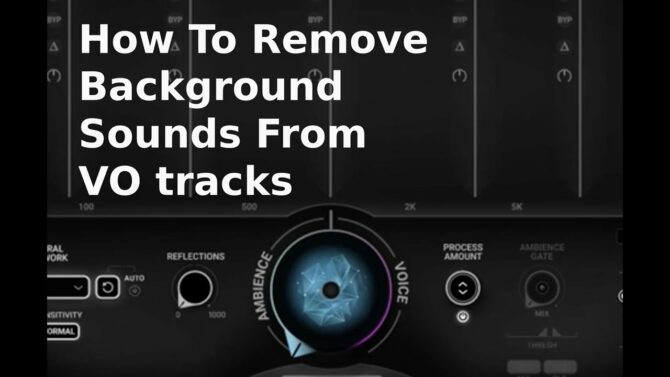One result of the COVID-19 Pandemic is that more people than ever are working from home. Even after the pandemic subsides, though, some companies may decide not to spend so much money on office space, because employees can sometimes be more—not less—productive when working from home. This doesn’t mean an end to interpersonal interaction, but it does mean that the home office will take on increased importance for the foreseeable future.
Part of that importance means that a home office needs to up its game—doing teleconferences with a laptop camera pointing at a ceiling fan won’t cut it, and a mic without a mute Definition:
Definition:
1. To silence or squelch an audio signal. 2. A switch that silences a signal. button is asking for trouble. What’s more, quality sound takes on increased importance for presenting proposals and demos. If you want to stand out to your clients or employer, your home office needs to be more than just a place with a desk and a couple monitors.
Fortunately, a pro makeover is neither difficult, nor expensive—and the results are worth it. Part 1 covers how to improve your audio quality, while part 2 concentrates on video.

Choosing the Right Mic
Most laptops and monitors have a built-in mic, but you’re better off if you pretend it doesn’t exist—you’ll need three important elements for better conference call audio. The AKG Podcaster Essentials toolkit is an excellent choice (Fig. 1), because it has all three elements (it also looks cool on camera).
- A quality USB mic. These are simple to set up, because you don’t need a separate audio interface
 Definition:
Definition:
A device to convert audio signals into digital code suitable for use by a computer; typically communication occurs through a port such as USB, Thunderbolt, FireWire, etc. or preamp—just plug Definition: A connector, normally male and attached to a cable. it into a USB
Definition: A connector, normally male and attached to a cable. it into a USB Definition: (Universal Serial Bus) A standard, bi-directional serial connection between computers and peripheral devices. port on your computer. (Using a hub isn’t recommended, but if you have to use a hub, a powered type is best.)
Definition: (Universal Serial Bus) A standard, bi-directional serial connection between computers and peripheral devices. port on your computer. (Using a hub isn’t recommended, but if you have to use a hub, a powered type is best.) - Mute switch. I can’t emphasize how important this is. When there are a dozen people on a call, any background noise causes real problems, so it’s important to mute your voice when not talking (as well as if you need to clear your throat). You want a prominent, obvious switch.
- Headphones. Many USB mics designed for podcasting (including the AKG Lyra mic in the AKG Podcaster Essentials) have headphone jacks and accompanying volume controls. Traditional speaker phones are horrific for conference calls because of the possibility of sound from the speaker getting into your mic, and causing feedback
 Definition:
Definition:
1. A squealing, chirping, or ringing sound when a microphone feeding a loudspeaker picks up audio from that loudspeaker. Also called howlround. 2. The state where a device's output connects back to the input.. You want circumaural Definition:
Definition:
A headphone that fits around the ear rather than on top of the ear, and exerts pressure on the head. (sealed, around the ear) headphones, or in-ear monitors, because the leakage from open-back headphones can sometimes lead to feedback. Note that you can eliminate a headphone cable by driving wireless Bluetooth Definition:
Definition:
A short distance (less than 33 feet) wireless data transfer standard. headphones from your computer. However, this does add delay Definition:
Definition:
A device that outputs and input signal some time later. This can be short for echo effects, longer for matching speaker stacks, or aligning sound and video. to the latency Definition:
Definition:
The amount of delay a signal, data, sound, video, or control signal acquires within a device, system, or long-distance connection. that’s already happening with most internet-based calls. There may also be more technical complexity, because you likely need to control headphone levels from the computer.

Adjustable polar pattern
This isn’t necessarily essential, but if you anticipate having more than one person in your office participating in a call, you need to pick up everyone with equal clarity. For example, the Lyra mic offers four pickup Definition:
Definition:
1. Transducer attached to a musical instrument that converts mechanical vibrations into an electrical signal for recording or amplification. 2. The part of a phonograph that translates mechanical motion from grooves into electrical signals for subsequent amplification. patterns: front, front and back, tight stereo Definition:
Definition:
A two channel signal simulating a sound space, typically played through two speakers., and wide stereo. If it’s just you, speak into the front. Use front and back when placing the mic between two people sitting across from each other, stereo for interviews where you’re sitting next to someone, and wide stereo for larger groups of people.
Using the Mic
Now that you have a mic squared away, you need to use it correctly. Mount the mic properly. The Lyra has an integrated desktop mic stand, which will likely be all you need. However, its footprint Definition:
Definition:
The amount of desk or floor space taken up by a computer or similar device. will take up some desk space in front of you, or slightly off to the side. Also, sometimes a desktop stand will transfer noise from a desk (e.g., heavy typing), which creates “thumps” in the audio. Fortunately, you can detach the mic from the base, and mount it to a boom mic Definition:
Definition:
A highly directional mic for video/film-sound held on a pole, typically over an actor and out of the frame. stand (Fig. 2).

Note that unlike recording situations where the stand may have to support heavy, expensive mics, you can use a lighter, less expensive stand. Also consider choosing a stand that’s easy to fold up and store. The On-Stage MS7701B has tripod legs, which can fold down. If you then straighten the boom Definition:
Definition:
A vertical stand or tree on which horizontal boom arm is attached, also handheld microphone (fishpole) arm for overhead recording. against the stand and set the arm to its minimum length, the mic stand fits unobtrusively in the corner of a closet until needed.
The only drawback is that if you plug your headphones into the mic, the trailing headphone cable may be awkward. Buy a 3.5 mm, male-to-female stereo extension cable like the Cables To Go (Fig. 3), then tape it to the boom arm Definition:
Definition:
A horizontal arm attached to a stand for mounting microphones or lights or scenic equipment. and run it down the stand, along with the USB cable going to the mic itself. You can leave the cable taped in place when you store the boom and stand, so everything will be ready to go at a moment’s notice.
Another advantage of a mic stand is that if you have problems with p-popping, you can mount a pop filter Definition:
Definition:
A microphone accessory, typically made from a plastic or metal mesh, placed between a vocalist or narrator and a microphone to reduce wind noise or breath blasts. like the Gator GM-Pop Filter to the stand (Fig. 4), and place the filter Definition:
Definition:
1. (audio) A circuit that reduces certain frequencies, e.g., a low-pass or high-pass filter for audio. See also: Equalizer. 2. (optics) reduces certain color wavelengths or polarizations. in front of the mic.

Choose the right mic in your computer
Both MacOS and Windows computers have control panels for audio, whose settings often default Definition:
Definition:
A value assumed initially by a device, particularly a computer-based device, until changed. to an internal mic and speaker. Make sure the audio input is set to your spiffy new USB mic, and the output goes to the headphones. I’ve known people who didn’t realize this kind of setup was necessary, and whose voices ended up being picked up by a laptop’s internal mic instead of the USB one—and then they wondered why the USB mic sounded so bad.
Proper mic technique
This is crucial, because good gear Definition:
Definition:
Musical or performance equipment. will take you only so far. USB mics designed for podcasting are often quite sensitive, because they’re not going to be recording drums and guitar amps. The Lyra has a mic gain Definition:
Definition:
The amount of amplification provided by an amplifier circuit, expressed in dB or numerically as in "3X" = "3 times". control on the back; avoid getting in close to the mic with high mic gain settings. Speak about a foot from the mic (this helps reduce popping, mouth clicks, and the like—don’t “swallow” the mic), aim your voice a little to the side of the mic instead of the center, and use a moderate amount of gain.
With any home office setup, test the audio quality before using your mic for business. Initiate an internet-based conversation with a friend, and try different mic gain settings while making sure your mouth is at a consistent distance from the mic. You’ll eventually find a “sweet spot” for the mic gain that’s not so high that it brings up noise and hiss Definition:
Definition:
Random noise that is inherent in electronics-based audio equipment., but not so low that your voice isn’t intelligible.
And don’t forget the acoustics…

Hearing a voice that sounds like it’s in an echo chamber Definition:
Definition:
A room with a speaker and microphone for creating reverberation effects. can be really distracting, as well as decrease intelligibility. Unfortunately, most rooms serving as home offices weren’t designed with sound-deadening acoustics in mind. Hard surfaces reflect sounds back into the mic, and the reflections interfere with your voice. The same windows that provide wonderful views are also tough on acoustics. Isolation shields, like the Tascam TM-AR1 (Fig. 5), go behind the mic and isolate it from reflections.
Unfortunately, this is useful pretty much exclusively for audio-only presentations. For video, the shield hides the person, and might also hide a computer screen behind it that you need to see. If you’re recording a presentation, an isolation shield can be useful. Otherwise, you’ll need to pursue other solutions.
Acoustical ceiling tiles, available from local hardware stores, can help control reflections. An even simpler, and more temporary, solution is to attach a sheet or quilt to your ceiling. It doesn’t matter if there’s an air gap between the ceiling and fabric, in fact, that improves the sound-trapping abilities. Underlying technologies include Ethernet, WiFi and Thread. if there’s an air gap between the ceiling and fabric, in fact, that improves the sound-trapping abilities. If your windows have curtains, draw them closed if they’re not needed for natural lighting. You can also hang fabric room dividers.

But if you really want to go pro, there’s a wide variety of sound-absorbing panels available at Full Compass to fit all sizes and budgets. Some can actually enhance your décor, and look good on camera. The Auralex B224PET panels (Fig. 6) are 4’ x 2’ by 2” thick, come in a variety of colors, and are comparatively inexpensive. Placing a few of these strategically against hard surfaces can improve the acoustics, and thus, the audio quality.
The bottom line is that if you’re a professional, you need to sound like a professional. Even these simple, cost-effective tweaks will make a big difference in how you’re perceived by your business partners.
However, you also need to look good as well as sound good—so check out Home Office Pro Makeover, Part 2: Better Video.





















